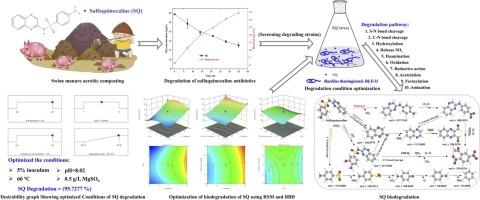响应面法及Box-Behnken设计优化芽孢杆菌菌株DLY-11对磺胺喹啉的去除效果及降解机理
IF 11.3
1区 环境科学与生态学
Q1 ENGINEERING, ENVIRONMENTAL
引用次数: 0
摘要
抗生素污染,特别是在畜禽养殖环境中磺胺喹诺啉(SQ)残留的持久性,已成为一个紧迫的环境问题。尽管如此,对微生物有效降解SQ的优化条件和机制的了解仍然有限。为了解决这一知识差距,我们从好氧堆肥中分离出芽孢杆菌sp.菌株DLY-11,该菌株表现出卓越的SQ降解能力。采用响应面法和Box-Behnken设计优化条件:接种量5%,60°C, pH 8.02, 0.5 g/L MgSO4。菌株DLY-11在2 d内实现了95.5%的SQ降解。我们鉴定了12种降解产物,其中包括一种新报道的降解产物,并提出了4种降解途径,包括S-N和C-N键裂解、羟基化、SO2释放、脱氨、氧化、乙酰化和甲酰化。其中一种建议的途径是全新的,以前没有在文献中报道过。这项工作通过优化降解条件和引入有效分解SQ的有用微生物资源,填补了细菌降解途径中的重要信息空白。这也为解决畜禽生产中抗生素污染问题提供了坚实的理论基础。本文章由计算机程序翻译,如有差异,请以英文原文为准。

Response surface methodology and Box-Behnken design optimization of Sulfaquinoxaline removal efficiency and degradation mechanisms by Bacillus sp. strain DLY-11
Antibiotic pollution, particularly the persistence of Sulfaquinoxaline (SQ) residues in livestock and poultry farming environments, has emerged as a pressing environmental concern. Despite this, there remains a limited understanding of the optimized conditions and mechanisms for the efficient degradation of SQ by microorganisms. To address this knowledge gap, we isolated Bacillus sp. strain DLY-11 from aerobically composted manure, which exhibits exceptional SQ degradation capability. Using response surface methodology and Box-Behnken design, we optimized the conditions: 5 % inoculum, 60 °C, pH 8.02, and 0.5 g/L MgSO4. Strain DLY-11 achieved 95.5 % SQ degradation in 2 d. We identified 12 degradation products, including one newly reported, and proposed four degradation pathways involving S-N and C-N bond cleavage, hydroxylation, SO2 release, deamination, oxidation, acetylation, and formylation. One of the proposed pathways is entirely new and has not been previously reported in the literature. This work closes important information gaps in the bacterial degradation pathways of SQ by optimizing the degradation conditions and introducing a useful microbial resource for the effective breakdown of SQ. It also provides a solid theoretical foundation for tackling the problem of antibiotic contamination in livestock and poultry production.
求助全文
通过发布文献求助,成功后即可免费获取论文全文。
去求助
来源期刊

Journal of Hazardous Materials
工程技术-工程:环境
CiteScore
25.40
自引率
5.90%
发文量
3059
审稿时长
58 days
期刊介绍:
The Journal of Hazardous Materials serves as a global platform for promoting cutting-edge research in the field of Environmental Science and Engineering. Our publication features a wide range of articles, including full-length research papers, review articles, and perspectives, with the aim of enhancing our understanding of the dangers and risks associated with various materials concerning public health and the environment. It is important to note that the term "environmental contaminants" refers specifically to substances that pose hazardous effects through contamination, while excluding those that do not have such impacts on the environment or human health. Moreover, we emphasize the distinction between wastes and hazardous materials in order to provide further clarity on the scope of the journal. We have a keen interest in exploring specific compounds and microbial agents that have adverse effects on the environment.
 求助内容:
求助内容: 应助结果提醒方式:
应助结果提醒方式:


